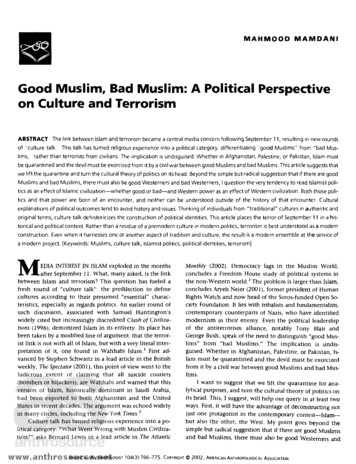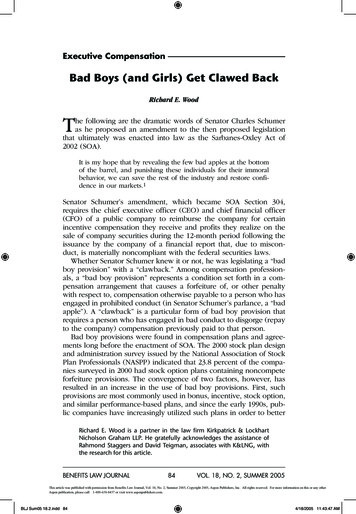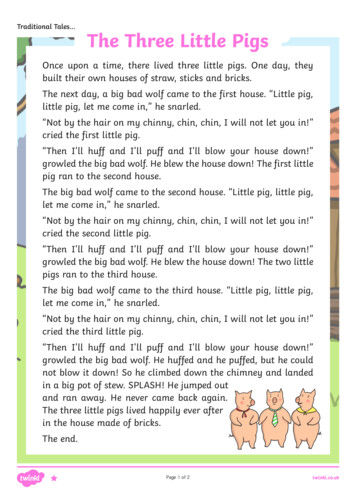
Transcription
From ‘bad’ to ‘good’: Baroque architecture through a century ofart historiography and politicsReview of:Evonne Levy, Baroque and the Political Language of Formalism (1845-1945):Burckhardt, Wölfflin, Gurlitt, Brinckmann, Sedlmayr, 400 pp., 42 ills, Basel:Schwabe, 2015. 68, ISBN 978-3-7965-3396-9Marco M. MascoloAmong the theoretical patterns that shaped art history between the nineteenth andtwentieth century, formalism has undoubtedly a central place, with the turningpoint of Heinrich Wölfflin’s publication of the Kunstgeschichtliche Grundbegriffe(Principles of Art History) in 1915, which offered practical tools to interpret worksof art on the basis of the historical forms of sight.1One of the crucial contributions of early twentieth-century German formalistscholars was the creation of the conditions to reconcile modernity with the Baroque.Directing her attention to the architectural historiography of the Baroque from 1845to 1945, Evonne Levy points out that ‘political circumstances pressed those whostudied the history of art to compare that epoch [i.e. the seventeenth century] totheir own’.2 The temporal frame defines a century that had, at its beginning, JacobBurckhardt’s entry ‘Jesuitenstil’ for the ninth edition of the Conversations-Lexikon3(chapter one) and, at its end, the downfall of Hitler’s Third Reich, with theconsequent scrutiny on methods compromised with the National Socialist regime,as in the case of art-historical works of Albert Erick Brinckmann (chapter four) andthe Austrian Hans Sedlmayr (chapter five).4 In the middle, the book follows theideas of two of the most important baroquists of the first half of the twentiethcentury: Heinrich Wölfflin (chapter two) and Cornelius Gurlitt (chapter three).With this book the author offers the possibility to recuperate a politicaldimension of the formalist theories; in other words, to look at political influencesshaping the positions of the art historians Levy analyses. To a certain extent, thismeans to offer a key to historicise formalism as well.An important historical frame to understand the author’s choice is offered bysituation of the history of art at its beginnings as an academic discipline inGermany. German art history was indeed characterised by an important self-criticalHeinrich Wölfflin, Kunstgeschichtliche Grundbegriffe. Das Problem der Stilentwicklung in derneuren Kunst, München: Bruckmann, 1915.2 Levy, Introduction, p. 15.3 Jacob Burckhardt, Jesuitenstil, in Allgemeine deutsche Real-Encyklopädie für die gebildetenStände: Conversations-Lexikon, Leipzig: Brockhaus, 1845, s. v.4 Levy in the present volume, 360-61.1Journal of Art Historiography Number 15 December 2016
Marco M. MascoloFrom ‘bad’ to ‘good’: Baroque architecturedebate about the originality of German art5 and, as Levy argues, Baroque offered away for architectural historians to resolve this long-debated problem. From theissue posed by nineteenth-century Romantics about cosmopolitanism in Germanculture against national character, through the recognition of the Baroque as anessentially German Formgefühl (feeling for form) around 1900, architecturalhistorians faced inexorably the political implications of such views. This politicaldeclination of the concept of the Baroque assumed through the century examinedimplies, following Levy, that Baroque emerged as a landmark theme in particularmoments and in particular places. But instead of facing problems posed bynationalism and national identity – of course, one of the main themes in the agendaof art historical debates at the turn of the twentieth century, that had also importanteffects on the concept of the Baroque – Levy chooses a slightly different approach,concentrating her interpretative efforts on the formal language shaped by the fiveGermanophone art historians she examines. If this could appear a way to sidestep amain theme of the art historical debate at the end it proves to be a rather prolificone, especially because it allows Levy make important considerations valid both forthe general problem of the political language used to define Baroque and for thespecific responses and strategies art historians choose to deal with the Baroque.Burckhardt among the formalistsThe place Burckhardt – the first scholar Levy deals with – occupies in this historycould be considered as symptomatic. As a Swiss citizen and deeply involved in thefate of the Swiss federation around the 1840s, which was at that time divided by astark contrast between liberals and conservative politics, for Burckhardt the crucialproblem in defining the Jesuitenstil in 1845 was the question about the opportunityto allow Jesuits to teach in the Lucerne canton. In his view, Jesuits were ‘insincere intheir architecture’6, embracing completely the Italian architectural style, whichmeans a Catholic style placed in Protestant cantons. Burckhardt’s Jesuitenstil allowedhim to consider the radicalization of the political situation in Switzerland and wasregarded as the evil counterpart of the more ‘sincere’ Gothic style.Levy points out that Burckhardt was building up the concept of Jesuitenstilexactly in coincidence with the Gothic rebuilding of Cologne cathedral, and that thisshaped profoundly Burckhardt’s view of the Jesuits as constantly foreign to theGerman context, into which they acted as an extension of Catholic CounterReformations issues. Following the evolution of the concept in Burckhardt’swritings and through his travels in Italy, Levy explains how the Barockstylsupplanted the former term to designate the style of the Roman CounterReformation: in fact in the Cicerone, first published in 1855, the Jesuitenstil is only apart of the more general Barockstyl.And Levy goes further underlying that putting aside the former category,Burckhardt replaces it with the Baroque from the art-historical point of view whichwent hand in hand with the Counter-Reformation, a recently introducedclassification in the historical field, to be intended as ‘the Jesuit reconquest ofHans Belting, The Germans and Their Art: A Troubled Relationship, Chicago: University ofChicago Press, 1989.6 Burckhardt, Jesuitenstil, quoted in Levy, Baroque, 3952
Marco M. MascoloFrom ‘bad’ to ‘good’: Baroque architecturepreviously Reformed territories’.7 After his Italians voyages, particularly to Rome,where Burckhardt achieved a better comprehension of the Baroque, a gradual shiftoccurred: from a basic negative conception of the architectural style of theseventeenth century, to a recuperation of the Baroque as the last moment of a wholeunified world. This shift, Levy argues, occurred in a completely transformedpolitical situation. That was the moment when the historian elaborated hisErinnerungen aus Rubens (published only after Burckhadrt’s death)8, where the artistoffers the precise will of expression of a new image of the world through hispaintings. To follow Burckhardt and his different perspectives about Baroque,through different moments of his life, means to recuperate a sort of pre-history ofthe concept, and it is functional for Levy’s narration, for Burckhardt’s pupilHeinrich Wölfflin will develop his positions.Wölfflin’s political viewTogether with the chapter about Cornelius Gurlitt and his three volumes onEuropean Baroque, the analysis of Wölfflin’s way to the recuperation andappreciation of the Baroque is the cornerstone of the book. And this is particularlyfunctional for Levy to demonstrate, following Martin Warnke’s insights about thepolitical commitment of Wölfflin’s Principles,9 how much and to what extentWölfflin formalism was also shaped by political and philosophical points of viewthat had their origins in the German context between the end of the nineteenth andthe beginning of the twentieth century.10As in the case of the other scholars examined by Levy, Wölfflin’s Baroque isparticularly revealing of his political ideas, influenced by political philosophyproposed by Wilhelm Heinrich Riehl, whose lectures Wölfflin heard in 1883 and,more important, Heinrich von Treitschke, whose courses Wölfflin followed in Berlin(1885-86).11 The crucial theme debated at the time (and that recurs in Levy’s chapteron the Swiss scholar) was the state and the form it should assumed and, as Levypoints out on the basis of the analysis offered by Woodruff Smith,12 this was notonly an essential point of the history as a discipline taught in German universities,but also of the cultural science in the broader sense. Thanks to the analysis ofWölfflin’s notebooks that were not published in Joseph Gantner edition13 LevyLevy, here 66.Jacob Burckhardt, Erinnerungen aus Rubens, ed. by Edith Strucholz and Martin Warnke,Basel: Schwabe and München: Beck, 2006 (vol. 11 of Burckhardt, Werke: KritischeGesamtausgabe)9 Martin Warnke, ‘On Heinrich Wölfflin’, Representations, 27, Summer 1989, 172-187.10 On Wölfflin’s commitments with philosophical theories see in particular Daniel Adler,‘Painterly Politics: Wölfflin, Formalism and German Academic Culture, 1888-1915’, ArtHistory, 27: 3, June 2004, 431-456.11 Levy, Baroque and the Political Language, especially 113-15. Heinrich von Treitschke,Deutsche Geschichte im neunzehnten Jahrhundert, 5 vols, Leipzig: Hirzel, 1879-94.12 Woodruff D. Smith, Politics and the Science of Culture in Germany 1840-1920, New York:Oxford University Press, 1991.13 Joseph Gantner, ed., Heinrich Wölfflin 1864-1945: Autobiographie, Tagebücher und Briefe, rev.ed., Basel: Schwabe 1984. Wölfflin’s notebooks and papers are preserved in Basel,Universitätsbibliothek.783
Marco M. MascoloFrom ‘bad’ to ‘good’: Baroque architecturereconstructs the interest the scholar had in problems concerning the political form ofthe state and its history within the relationship it had with ‘a history as psychicdevelopment, which functions according to laws not only in the realm of the state,but also in that of art, of philosophy, and so on’.14 This sheds a light, also, onWölfflin’s preoccupation with understanding his present, a condition he judgedcrucial to gain a comprehension of the past.15All these complex and coherent concepts had a profound influence onRenaissance und Barock (1888), which shows the traces of the debates of the 1880supon the relationship between the individual and the state.16 So the categories ofgrosser Style (grand style), of Massigkeit (massiveness), Wölfflin used to describe theoverwhelming effect of the totality of architecture upon its individual elements(columns, for example) becomes a trace of the political thought of the author. Thepassage from Renaissance und Barock to the Klassische Kunst (1899)17 is marked by theshift from the attention to the state and the relations that governed part and thewhole of the social structure.The ‘social turn’, as Levy defines it,18 was induced by the political situation ofthe 1890s, marked by the rise of socialism. The analysis of Klassische Kunst, whereWölfflin concentrates his hermeneutic efforts on the art of the fifteenth and sixteenthcenturies, may seem a topic out of the scope of the book. But its inclusion in aBoroque-focused research helps to understand the politicization of these themes,and to explain how Wölfflin passed from a substantially negative conception of thewhole architectural mass as ‘oppressive’ to a positive conception of the whole as aunifying element; an element, which he will individuate as typical of the Baroque.The eye and the vision, which became ‘thinking organ’, drove this shift. Shortly,Klassische Kunst appears as the fundamental passage to the formal analysis, avoidinghistorical and cultural explanations.19 Of course an in-depth analysis is devoted tothe pilaster of Wölfflin’s formalist system: the above-mentioned KunstgeschichtlicheGrundbegriffe.20 What emerged are the connections with the themes Wölfflin startedWölfflin, Notebooks 15 (1887-88), fol. 19, Wölfflin Nachlass, quoted in Levy, 114, with theoriginal text in German, 161-2, note 83.15 This point is particularly evident from the passages Levy quotes from the scholar’snotebooks: 115.16 Heinrich Wölfflin, Renaissance und Barock: Eine Untersuchung über Wesen und Entstehung desBarockstils in Italien, München: Ackermann, 1888. About this book and its reception in thecontext on National Socialism see the important contribution by Arnold Witte, ‘‘Anappendix of manageable proportions’. Heinrich Wölfflin and Hans Rose between Baroquestudies and National-Socialism’, Journal of Art Historiography, 14, June 2016.17 Heinrich Wölfflin, Die Klassische Kunst. Eine Einführung in die Italienische Renaissance,München: Bruckmann, 1899.18 Levy, 120.19 About this point see Maurizio Ghelardi, ‘Il cavaliere e il Bodensee. Heinrich Wölfflin e ilSentimento tedesco della forma’, in Claudia Cieri Via, Elizabeth Kieven, Alessandro Nova,eds, L’Italia e l’arte straniera: la Storia dell’arte e le sue frontiere. A cento anni dal X CongressoInternazionale di Storia dell’arte in Roma (1912). Un bilancio storiografico e una riflessione delpresente, Rome: Accademia Nazionale dei Lincei, 2015, 53-64, especially 58.20 In the book Levy expands the considerations anticipated in the introductory essay in the2015 English edition of the Grundbgriffe: Levy, Wölfflin’s Principles of Art History (19152015): A Prolegomenon for Its Second Century, in Heinrich Wölfflin, Principles of Art History. TheProblem of the Development of Style in Early Modern Art. One Hundredth Anniversary Edition,144
Marco M. MascoloFrom ‘bad’ to ‘good’: Baroque architectureto develop in the Klassische Kunst and, to a certain extent, their radicalization. In thiswork Baroque is interpreted as the moment when the formation of the modernsensibility arose and took a recognizable form. Levy tries to detect the politicalnuances crouched in the pages of this landmark book to give them too arecognizable form investigating some of the fundamental differences between whatis detectable as a ‘classic’ style and a ‘baroque’ one, differentiated among them, forexample, from the point of view of the concept of ‘unity’ (Einheit).21The final part of Levy’s considerations on Wölfflin is devoted to his book of1931, Die Kunst der Renaissance: Italien und das deutsche Formgefühl, which deals withnational differences. The point was a fundamental one, which Wölfflin has beenthinking since at least his arrival at Berlin University in 1901.22 From that momentonward he began to think about the Italian Renaissance and the role it had forGerman art. An intermediate stage of the development of the book was themonograph Wölfflin devoted to Dürer in 1905,23 which offered the example of therole Southern art had for a Northern artist. Levy analyses the positions expressed inthe book through the theories of Wilhelm Wundt’s Völkerpsychologie and FriedrichMeinecke’s book about cosmopolitanism published in 1908.24 The description ofWölfflin’s political thought in terms of evolution from one step to another is ofcourse functional to the exposition, but it is important to underline that manythemes had multifaceted aspects, and the shift from one to another was not soclearly stated as it could appear from some passages of the book.Gurlitt and the European BaroqueThe chapter devoted to Gurlitt, as said, is the other pillar of the book. Under focus isGurlitt’s monumental work on the Geschichte des Barockstiles und des Rococo, a seriesof three volumes devoted to the Baroque and Rococo in Europe published inStuttgart from 1887 to 1889.25 Gurlitt, as Alina Payne puts it ‘is one of those figurewho straddled the disciplines and in whose work a lot of threads came together –art history, architecture, Kunstgewerbe’26. He was an architect, a journalist, atranslation by Jonathan Blower and essays by Evonne Levy and Tristan Weddigen, LosAngeles 2015, 1-46. On this new edition see also Arnold Witte, ‘Wölfflin’s Grundbegriffe as apsychological palimpsest?’ in Journal of Art Historiography, 13, December 2015.21 See especially 142-3.22 As for the 1931 book and its importance for Wölfflin see Nikolaus Meier, ‘Italien und dasdeutsche Formgefühl’, in Helmut Pfotenhauer, ed., Kunstliteratur als Italienerfahrung,Tübingen: Niemeyer, 1991, 306-27; Ghelardi, ‘Il cavaliere e il Bodensee’, 53-64.23 Heinrich Wölfflin, Die Kunst Albrecht Dürers, München: Bruckmann, 1905.24 Friedrich Meinecke, Weltbürgertum und Nationalstaat. Studien zur Genesis des deutschenNationalstaat, München and Berlin: Oldenbourg, 1908.25 Cornelius Gurlitt, Geschichte des Barockstiles und des Rococo in Italien, Stuttgart: Ebner &Seubert, 1887; Gurlitt, Geschichte des Barockstiles und des Rococo und des Kalssicismus in Belgien,Holland, Frankreich, England, Stuttgart: Ebner & Seubert, 1888; Gurlitt, Geschichte desBarockstiles und des Rococo in Deutschland, Stuttgart: Ebner & Seubert, 1889.26 Alina Payne, From Ornament to Object. Genealogies of Architectural Modernism, New Havenand London: Yale University Press, 2012: 187.5
Marco M. MascoloFrom ‘bad’ to ‘good’: Baroque architectureprofessor at the Technische Hochscule in Dresden, and had a crucial role inproposing Neo-Baroque architectural style as highly representative for Germany.27When investigating Gurlitt’s family, particularly the influence his father,Louis, had on the young Cornelius, Levy individuates Gurlitt’s Protestantism as acentral aspect in his interpretation of the Baroque. This is particularly evident in thethird of his volumes, devoted solely to German Baroque art. The confessional forcesin the field – Jesuit, Huguenot, Protestant, and Catholic – contribute to shape theformal qualities of the Baroque. Gurlitt’s complex positioning of the Jesuit style andof the Catholic Baroque is extensively clarified by Levy, and the contrast betweenthem is individuated as one of the core themes of the book on German Baroque.The milieu to which Levy leads Gurlitt’s positions is the one that emerged inthe 1870s, when the pope demanded Catholics to be loyal to Rome with the syllabusof 1870. This complex political and historical moment reverberated into Gurlitt’s arthistorical work and Levy follows this path around three main themes that, sheargues, Gurlitt inherited from Treitschke’s Deutsche Geschichte28: the confessionalfreedom, the unity of the state and – as it was for Wölfflin – the relation of theindividual to the state.29 Gurlitt individuated the modern Italian states of the RomanChurch and the Tuscan court in the seventeenth century as the places where theconditions for the Baroque were created, or, in other words, the condition of anabsolute power that subsume the individuality under the whole.Gurlitt’s analysis of the Italian Baroque is to some extent functional to provethat when architecture in the Italian style began to appear in Germany, it was ‘notfor lack of imagination or ideas of their own, nor because Germany was overrun byItalians, but out of kinship. The end of the Italian Baroque was already Germany’.30The diffusion of the Baroque across Europe – the theme of the second book of theBaroque trilogy – shows how political and confessional problems shaped Gurlitt’svision of the Baroque. So, for example, French and English architecture isinterpreted on the basis of their political history, which was marked by the conquestof political unity long before Germany.At the end of the chapter Levy offers a brief overview of the reception ofGurlitt’s books, by concentrating especially on Wilhelm Pinder’s interpretation ofGurlitt, a symptomatic exception to the general superficial reception the trilogy hadhad.Brinckmann and Sedlmayr: the explicit politicization of the BaroqueThe last two chapters of the book are devoted to Albert E. Brinckmann and HansSedlmayr. But the path followed here is, to some extent, different from the one Levyadopted for the first ones. The analysis now concentrates on two scholars deeplycommitted to National Socialism who gave (although from different perspectives)similar responses to the crucial questions about the political and historical problemsof their time.See also Payne, From Ornament to Object, 187-93.See note 11 above.29 For Levy’s analysis of Treitschke influence on Gurlitt: 189-92.30 Levy, here 197.27286
Marco M. MascoloFrom ‘bad’ to ‘good’: Baroque architectureTo Brinckmann, for example, the pivotal experience was his enrolment in thepropagandist service in The Hague during World War I. Faced with the necessity torecuperate Germany’s reputation after the destruction of Belgian and Frenchmonuments, Brinckmann’s activity was profoundly shaped by this experience up tothe 1940s. The core analysis is devoted to Geist der Nationen: Italiener – Franzosen –Deutsche,31 published for the first time in 1938, a book that proposed aninterpretation of the art of the three nations from the unified perspective of thenational art and the national spirit (Volkgeist). The national Geist was a crucialconcept for Brinckmann, the core concept underlying his analysis.Brinckmann gave a strong racial declination to his theories, an aspect thatdivided the reviewers of the book at the time of its publication.32 Levy analyses thedifferences between the 1938 edition and the 1948 one, showing how Brinckmannmodified some passages of the book to obtain a slightly different effect byeliminating, for example, all passages that pointed out the necessity of thesuperiority of Germany over Europe, or the introduction of artists unpopular inNazi’s Germany. Levy’s account of Brinckmann goes on analysing his highlyautobiographical book Geist im Wandel: Rebellion und Ordnung of 194633 todemonstrate Brinckmann’s intention to identify himself as a victim of the Nazis.Sedlmayr’s complex theoretical patterns are the argument of the last chapter.Levy outlines the art historian training in Vienna, where he studied with MaxDvorák until 1921, highlighting Sedlmayr’s Catholicism as one of the principalconcerns of his political conservatism. After characterising his rejection ofhistoricism through the Gestalt theories, Levy concentrates on Sedlmayr’s mostengaged works on the Baroque, but instead of proceeding as in the previouschapters analysing single works step by step, Levy offers here an overview of thedifferent positions Sedlmayr adopted through his career facing the Baroque.Sedlmayr’s 1930 book, Die Architektur Borrominis, rightly occupies the central placeamong the analysis of Sedlmayr’s works,34 but as Levy herself concludes ‘[t]heextent to which Sedlmayr’s Baroque was shaped by his political beliefs prior toReichsstil essay stubbornly resists a definitive answer’.35 The essay she refers is acontribution to a volume edited by two of Sedlmayr’s colleagues at ViennaUniversity,36 and into which Sedlmayr acted a consistent change from GestaltAlbert E. Brinckmann, Geist der Nationen: Italiener – Franzosen – Deutsche, Hamburg:Hoffmann und Campe, 1938.32 See especially: 275-76.33 Albert E. Brinckmann, Geist im Wandel: Rebellion und Ordnung, Hamburg: Hoffmann undCampe, 1946.34 Hans Sedlmayr, Die Architektur Borrominis, München: Piper, 1930. See the englishtranslation by Karl Johns, Journal of Art Historiography, 14, June 2016. Recently theintroduction Marco Pogacnik published in the Italian edition of Sedlmayr’s book(L’architettura di Borromini, Milan: Electa, 1996, 7-22) was translated in English: ‘Beyond theVienna School: Sedlmayr and Borromini’, in Andrew Leach, John Macarthur and MaartenDelbeke, eds, The Baroque in Architectural Culture 1880-1980, Aldershot: Ashgate, 2015, 97-108.35 Levy, 343.36 Hans Sedlmayr, ‘Österreichs bildende Kunst’, in Josef Nadler and Heinrich von Srbik, eds,Österreich. Erbe und Sendung im deutschen Raum, Salzburg: Pustet, 1936, 329-46. AboutSedlmayr see also the important article by Ian Verstegen, ‘Sedlmayr’s Borromini’, Journal of317
Marco M. MascoloFrom ‘bad’ to ‘good’: Baroque architecturetheories to embrace a political determined historical vision, according to the Germanexpansion that ended with the 1938 Anschluss. What emerged are the differentpaths that Sedlmayr crossed to get different approaches to formalism, particularlywith his turn, after 1930s, to an overtly politicised art historical criticism.The chapter offers, undoubtedly, useful insights into Sedlmay’s theories toward hiscareer, but seems mostly a thematic insight about the Second Vienna School37 andthe complex relation Sedlmayr had with Alois Riegl and his legacy.ConclusionThe purpose of Levy’s book is certainly ambitious, but although her analysis of thesingle art historians is compelling, the general theoretical frame into which they areincluded poses some problems. For example, to place Burckhardt among theformalists seems to force the boundaries of the category (or to force Burckhardtpositions). But, on the other hand, its inclusion is functional to drive attention to theinfluence he had on Wölfflin and on his formalism.An aspect that Levy poses clearly in her introduction is important: thenecessity to study and to examine the ‘biographical element’38 to understand howthe scholars she examines reacted to the historical circumstances they lived. Thisapproach is adapted to the object of the analysis, so in the case of Brinckmann andSedlmayr, Levy insists more about a horizontal view that embraced all their careersas art historians than she does in the cases, for example, of Gurlitt and Burckhardt,where she offers an in-depth analysis of single works, although she investigates thehistorical circumstances that shaped them.At the end, one may be wonder why Alois Riegl was not included in thebook. Riegl’s interest in the Baroque occupied his last years, and his late workscould be also examined by the point of view adopted in the book under review.39The problem posed by Levy, the possibility to detect a political elementbehind formalist theories about the Baroque, occurs in a general flow of attention tothat historical period which seems to have its momentum in recent years.40 Onlyafter 1945 the theoretical frame established at the beginnings of the twentiethcentury changed suddenly, but the Baroque remained a central question of arthistorical investigation. Maybe because, as Giulio Carlo Argan (1909-1992) wrote in1986, introducing a volume of his writings about the Baroque, ‘art historians of myArt Historiography, 14, June 2016. In the same number of the Journal was published atranslation of Sedlmayr’s Borromini by Karl Johns.37 About the Second Vienna School see especially Christopher S. Wood, ed., The Vienna SchoolReader: Politics and Art Historical Method in the 1930s, New York: Zone Books, 2003.38 Levy, here 24.39 About Riegl and the Baroque see Alois Riegl, The Origins of Baroque Art in Rome, edited andtranslated by Andrew Hopkins and Arnold Witte, with essays by Alina Payne, Arnold Witteand Andrew Hopkins, Los Angeles: The Getty Research Institute, 2010; Evonne Levy, ‘Riegland Wölfflin in Dialogue on the Baroque’, in Andrew Leach, John Macarthur, MaartenDelbeke, eds, The Baroque in Architectural Culture, 1880-1980, London-New York: Ashgate,2015, 87-96.40 See for example Baroque in the Architectural Culture, and Riegl, The Origins of Baroque Art;but also the expected work by Ute Engels, Stil und Nation. Barockforschung und deutscheKunstgeschichte (ca. 1830 bis 1933), Berlin: Wilhelm Fink.8
Marco M. MascoloFrom ‘bad’ to ‘good’: Baroque architecturegeneration saw the birth of the question of the Baroque exactly in the crucialmoment of their education. They carried it with them their whole life’.41Marco M. Mascolo studied at the University of Siena and at the Scuola NormaleSuperiore, Pisa, where he obtained his PhD in 2014. He is currently preparing abook about Wilhelm R. Valentiner (1880-1958), which will be published at thebeginning of 2017. Mascolo’ s current areas of research include the relationshipsbetween American and German museums between the two World Wars; Americancollections of Dutch Art; private and public collections in America during the 1920sand 1930s, especially in the field of Italian sculpture. His work is published in thejournals Annali della Scuola Normale Superiore di Pisa , Studi di Memofonte andProspettiva .marcomascolo@gmail.comThis work is licensed under a Creative Commons AttributionNonCommercial 4.0 International LicenseGiulio Carlo Argan, ‘Prefazione’, in Bruno Contardi, ed., Giulio Carlo Argan, Immagine ePercezione. Saggi sul barocco, Milan: Feltrinelli, 1986, VII: ‘Gli storici dell’arte della miagenerazione la questione del barocco l’hanno veduta nascere, proprio nel momento decisivodella loro formazione. Se la sono portata dietro tutta la vita’.419
Marco M. Mascolo From ‘bad’ to ‘good’ Baroque architecture 3 previously Reformed territories’.7 After his Italians voyages, particularly to Rome, where Burckhardt achieved a better comprehension of the Baroque, a gradual shift occurred: from a ba










